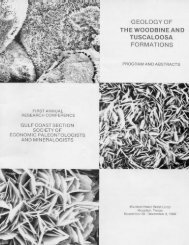Hiranya Sahoo - Gulf Coast Section SEPM
Hiranya Sahoo - Gulf Coast Section SEPM
Hiranya Sahoo - Gulf Coast Section SEPM
Create successful ePaper yourself
Turn your PDF publications into a flip-book with our unique Google optimized e-Paper software.
1. PROBLEMS, AND OBJECTIVES:<br />
Firstly, some latest critical reviews on fluvial studies (e.g. Schumm, 2005; Bridge, 2006;<br />
Ethridge, 2011) indicate that modern fluvial systems (comparing to ancient counterparts)<br />
manifest a far more complex heterogeneities ranging from continuum of planform (straight to<br />
meandering to braided) along with wide sedimentologic variation (grain size, mud content,<br />
bedform) at a spatio-temporal scale grossly discordant of any particular end-member stream<br />
character, and that the range and potential of these complexities have been poorly appreciated<br />
in rock record interpretation. To bridge this inadequacy of ancient fluvial description, Ethridge<br />
(2011) categorically recommends intensive documentation of all scale-variant sedimentologic<br />
attributes from fluvial preserved strata focusing evolution of river system at spatio-temporal<br />
scale that will generate first-approximations of range of fluvial heterogeneities as reflected in<br />
modern analog studies. Secondly, recent comprehension on modern fluvial depositional<br />
systems of continental sedimentary basins (e.g. Hartley et al., 2010; Weissmann et al., 2010)<br />
reveal that they are overwhelmingly distributive in character, and thus, this standpoint invokes<br />
for similar proposition to be scrutinized in fluvial rock record which has not been well<br />
constrained so far. To explore these two specifics, the proposed study attempts a regional-scale<br />
paleohyadraulic analysis from outcrop data of coastal-plain succession in the Wasatch Plateau,<br />
Utah.
















